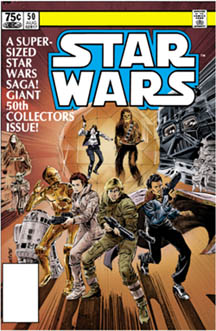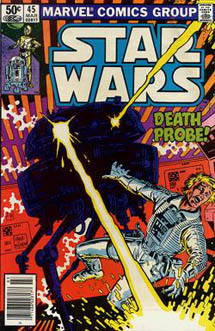The “Star Wars” Marvel comics run gets off to a rocky start after “The Empire Strikes Back” adaptation (issues 39-44), although the batch from 45-50 certainly has more than its share of talking points.
Issues 45, 47 and 50 marked the end of Archie Goodwin’s run as the series’ main author; he would hand the reins to David Michelinie with No. 51. Goodwin’s final three stories are marked by his usual smart writing, but he also makes perhaps the biggest gaffe of the whole series in “Death Probe” (No. 45) by inexplicably giving Luke a lightsaber.
Although Luke uses his blaster early on in the fight against a supersized probe droid, he pulls out a lightsaber toward the end. Either Goodwin forgot that Luke lost his saber in “Empire,” he assumed Luke got it back somehow, he thought Luke had an extra lightsaber laying around, or he thought Luke built a new lightsaber. All of those possible explanations deserved at least a panel of explanation. But we get absolutely nothing.
(In the letter column of Issue 48, Marvel’s Danny Fingeroth said they had received several letters asking where the new saber came from. While admitting that the real-world reason is that they didn’t want to tell stories where Luke didn’t have a lightsaber, Fingeroth suggests an in-universe explanation: Luke levitated it back up the Cloud City shaft. This explanation was later rejected by 1993’s “The Last Command,” when Timothy Zahn reveals that the Empire recovered Luke’s hand — and lightsaber — in order to make the clone Luuke Skywalker, who wields said lightsaber. Some have suggested that this mysterious Marvel lightsaber was given to Luke by the Rebellion, which had some old Jedi artifacts on hand. It should be noted that there are no stories outside of the Marvel comics where Luke has this particular lightsaber. In “Shadows of the Empire” he is working on building his green lightsaber, something he perfects in the opening pages of the “Return of the Jedi” novelization. So regardless of where the Marvel saber came from, we’re still missing a story where he loses it, thus necessitating the building of the green lightsaber. The Lucasfilm continuity gurus never provided an official explanation for this mysterious saber.)
Kids of the “Star Wars” generation will remember “Droid World” (No. 47), of course, because it was one of two Marvel issues adapted into a read-along record (the other being “Planet of the Hoojibs”). It’s a fun, if simplistic, tale of a warrior-turned-recluse named Kligson who prefers the company of droids. (Kligson should’ve had even stronger views about the rights of clones, but Goodwin didn’t have the prequels to draw on.)

And Goodwin bows out on a high note with the double-sized 50th issue, “The Crimson Forever,” in which he uses a flashback to get Han into the mix. The story is notable for having a horror element with the plague that turns people crimson, for venturing outside the galaxy, and for featuring a band of bounty hunters working for Domina Tagge, including IG-88 and Dengar (misnamed Zuckuss, and misspelled “Zuckass,” as was also the case in Goodwin’s newspaper strips).

The other three issues in this batch, by guest writers, are all bizarre and controversial. “The Dreams of Cody Sunn-Childe” (No. 46), by J.M. DeMatteis, mischaracterizes Lando Calrissian as someone who firmly believes warfare is the best way for the Rebellion to take on the Empire, and who counts a Rebel Alliance military legend (Cody Sunn-Childe) as a personal hero. This was the first Lando story published after “Empire,” so we were still getting a feel for the character, but I’d argue that even just based on the film, Lando is a guy who wants to be left alone by big government, and who joins up with our heroes out of moral obligation to Han Solo. He’s a reluctant revolutionary at best; but in this issue, he comes off as gung-ho for war when he shows disgust toward Sunn-Childe, who is now an avowed pacifist.
But the plot thickens. DeMatteis’ original ending had Lando pause and reflect on Sunn-Childe’s ideals as the Empire wipes out his defenseless colony. The Lucasfilm-approved final page finds Lando disgusted by Sunn-Childe’s sacrifice. The UK version of this story is DeMatteis’, but the U.S. version has the new final page and the pen name Wally Lombego because the author didn’t want to be associated with the opposite message from what he intended. You won’t find many examples of a publisher censoring pacifism in favor of a pro-war stance, but this is one. In his blog post, DeMatteis said Lucasfilm told him Sunn-Childe’s views made the heroes look bad, and that couldn’t be allowed. Thankfully, Lucasfilm’s intolerance for nuance and gray areas proved to be short-lived; otherwise, the Expanded Universe would be a lot less interesting.
“The Third Law” (No. 48), by Larry Hama, has one of the silliest set-ups of any Marvel issue: Leia goes to the banking planet Aargau to get a loan to buy X-wings, Darth Vader aims to stop her, and a battle of wits ensues. It’s bizarre that Leia and Vader are involved in this story to begin with, and everything gets weirder from there. In the end, Vader succeeds at his secret goal of stealing Leia’s Crown Jewels of Alderaan. Why would an Empire that rules by taxation and military force stoop to petty theft? And furthermore, would the Rebellion be operating so brazenly that Leia herself applies for a loan on a planet that treats banking transactions like public ceremonies? Also silly: Aargau doesn’t allow visitors to be armed — although all citizens are REQUIRED to own weapons (!) — but it does allow diplomatic pouches. So Leia and Vader both smuggle their weapons in that way. Leia and Vader are both out of character, with Vader being cunning rather than brutish, and Leia taking pleasure in outsmarting Vader (rather than being justifiably terrified by him).
“The Last Jedi” (No. 49), by Mike W. Barr, is one of those handful of Marvel yarns that seem to be set in feudal Europe rather than the galaxy far, far away. Like “Death Probe,” the issue is apocryphal because Luke has a lightsaber. It’s not a terrible story, though; now that I think about it, the machinations of planetary royalty on Velmor are reminiscent of a “Clone Wars” arc. It’s fun to see Luke and Leia go undercover, too — he sporting a mustache and eye patch, she sporting blonde hair. As for the “last Jedi” of the title, he’s a being (named “Jedi”) who briefly explored the ways of the Force before suffering brain damage. The concept is more interesting than the execution, though. Essentially, Luke learns a valuable lesson about looking down on people less fortunate than himself. This issue is also notable for its utterly strange depiction of a “modified Y-wing.” Although shaped like a Y-wing, it has the spaciousness of a freighter and it lands with wheels on runways.
Overall, these issues immediately following “Empire” give the impression of writers who don’t understand “Star Wars” (DeMatteis, for one, admits in his blog post that he wasn’t a fan) and editors being lazy with their oversight. But for all the misfires and oddities here, Goodwin tries to provide a framework for the post-“Empire” issues to come when he introduces a Rebel base on Golrath, a lava planet, in issue 50. It sets up the notion of the Rebellion being on the run from base to base during this time period, a thread that Michelinie will pick up when he takes the reins and restores a consistent vision to the saga.

